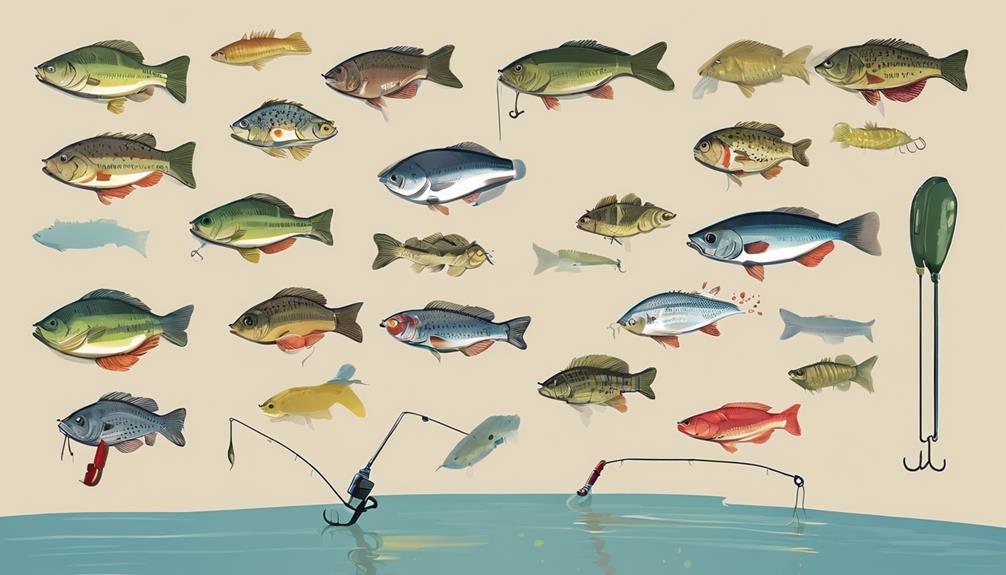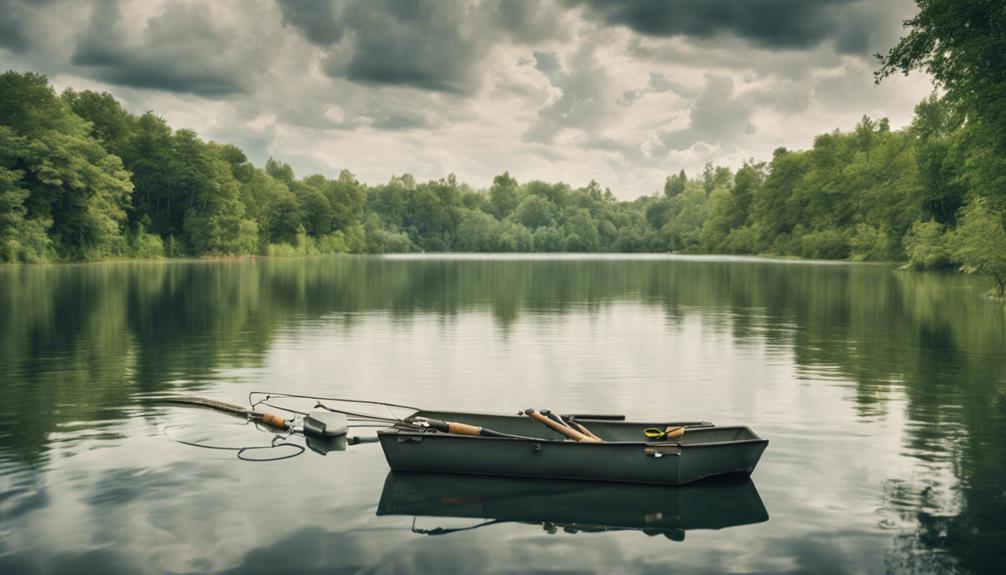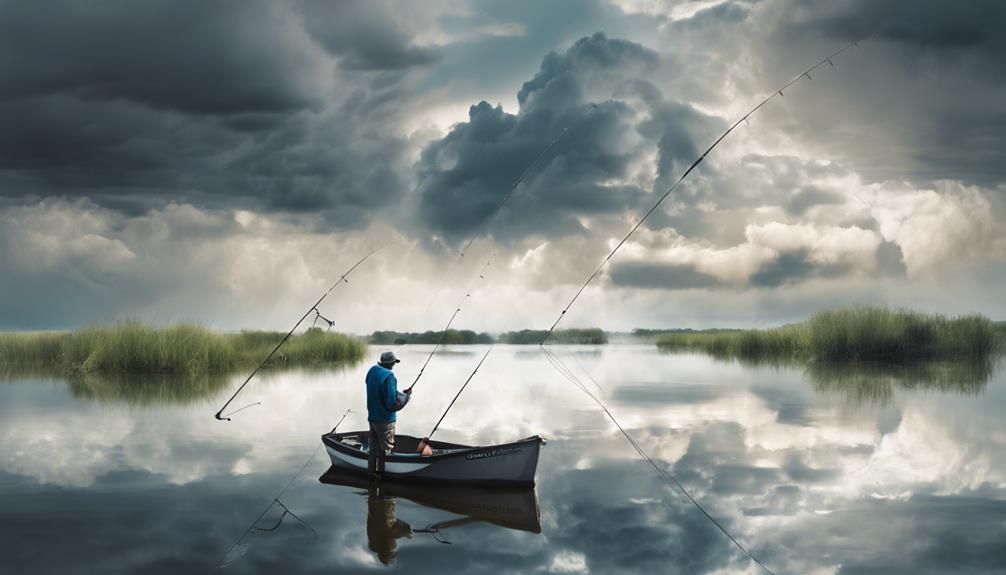When fishing, your bait selection should adapt to weather conditions. On sunny days, fish seek shade, so use live worms or brightly colored lures. In rain, opt for dark soft plastics that appeal to fish senses. Windy days call for techniques like kite fishing and baits that withstand movement. Overcast skies favor topwater lures and noises to attract fish. Foggy mornings require baits that create vibrations for visibility. In stormy seas, choose sturdy baits for safety. For crystal lakes, use topwater lures in calm waters. In turbulent waters, select baits that match currents. Enhance your fishing success by adjusting bait to weather conditions.
Sunny Skies: Bright Day Bait Choices
When fishing under sunny skies, selecting the right bait is crucial to attract fish effectively. In such conditions, fish tend to seek shelter in shady spots to avoid the direct sunlight. Understanding the bait preferences of fish during bright days can significantly increase your chances of a successful catch.
In shady spots, where fish seek refuge from the sun's intense rays, they often prefer live bait such as worms, minnows, or insects. These natural baits mimic what fish would naturally find in these areas, making them more enticing. Additionally, using brightly colored artificial lures that stand out in the shaded areas can also be effective in catching the attention of fish seeking cover.
When fishing in deep waters on sunny days, where fish may move to escape the warmth of the surface, it's essential to adjust your bait strategies. Deep-diving crankbaits or weighted jigs that can reach the lower depths where fish are hiding are excellent choices. These baits can mimic the movements of prey fish that seek cooler temperatures below the surface, attracting predatory fish looking for an easy meal.
Rainy Days: Adjusting Your Lure Selection
During rainy days, your lure selection needs to adapt to the changing conditions to maintain your fishing success. When faced with muddy waters due to rainfall, consider adjusting your bait strategies. In murky conditions, fish rely more on their lateral lines and sense of smell to locate prey rather than sight. Opt for lures that create vibrations and have strong scents to attract fish in these situations. Soft plastic baits like worms or creature baits in dark colors can be effective as they mimic natural prey and are easier for fish to locate in the turbid water.
In light rain, making subtle lure adjustments can improve your chances of a successful catch. Fish are typically less affected by light rain compared to heavy downpours, so finesse techniques can still be productive. Switching to smaller lures or using natural-colored crankbaits and soft jerkbaits can mimic the behavior of prey fish that are more active near the surface during rain showers. Additionally, topwater lures like poppers or frogs can create enticing movements that attract fish looking to feed on insects that may be falling into the water during light rain.
Windy Conditions: Matching Bait to Gusts
In windy conditions, selecting the appropriate bait that can withstand gusts and effectively attract fish is crucial for optimizing your fishing success. When facing strong winds while fishing, consider utilizing kite fishing or drift baiting techniques. Kite fishing involves using a kite to keep your bait at the desired depth and position despite the wind, allowing for better control and presentation. This method is particularly useful in windy conditions as it minimizes the impact of gusts on your bait.
Moreover, when dealing with windy conditions, choosing the right bait type can make a significant difference. Surface lures are excellent choices when the wind is creating ripples on the water's surface, as they can mimic the movement of prey fish and attract predators. On the other hand, deep diving baits work well in windy conditions by reaching below the surface disturbance caused by the wind, where fish may be seeking refuge.
Overcast Weather: Best Bait for Gray Days
During overcast weather conditions, anglers can enhance their fishing success by selecting the most appropriate bait to attract fish effectively. In light drizzle, fish tend to stay closer to the surface, making topwater baits like poppers or buzzbaits effective choices. The disturbance caused by these baits can draw fish in from a distance, enticing them to strike. Additionally, soft plastic jerkbaits or swimbaits in natural colors can mimic injured baitfish, which are more prevalent in overcast conditions, making them irresistible to predatory fish.
When heavy fog blankets the water, visibility decreases, impacting fish behavior. In these conditions, using lures that create noise or vibration can be effective. Lipless crankbaits with rattles or spinnerbaits with Colorado blades can attract fish by sound, compensating for the limited visibility. By triggering fish through their other senses, anglers can increase their chances of a bite. Another strategy is to use brightly colored lures to enhance visibility in the murky water. Chartreuse, orange, or red-colored lures can stand out more effectively, making it easier for fish to locate and strike them.
Adapting your bait selection to match the specific conditions presented by overcast weather can significantly improve your fishing outcomes. By understanding how light drizzle and heavy fog impact fish behavior, anglers can make informed choices that increase their chances of a successful fishing trip.
Foggy Mornings: Bait Picks for Low Visibility
When faced with foggy mornings and low visibility conditions while fishing, consider selecting bait that generates strong vibrations to attract fish effectively. In deep sea fishing during foggy mornings, deep diving lures and surface baits are excellent choices. Deep diving lures can reach fish dwelling in the lower depths, where visibility may be slightly better than at the surface. The action of these lures creates disturbances that can grab the attention of fish even in limited visibility. Surface baits, on the other hand, create commotion at the top, making them ideal for attracting fish that are feeding closer to the surface in the murky conditions of fog.
For shallow waters on foggy mornings, opting for topwater lures and sinking baits can yield positive results. Topwater lures create ripples and splashes on the surface, which can be particularly enticing for fish when visibility is low. The noise and movement these lures produce help fish locate the bait despite the fog. Sinking baits, on the contrary, sink below the surface and can be effective in enticing fish that prefer staying deeper in the water column during foggy periods. The subtle yet alluring descent of sinking baits can intrigue fish and lead to successful catches in shallow waters on foggy mornings.
Stormy Seas: Safest Bait Options
Consider adjusting your bait selection strategy for stormy seas to ensure safety and optimize your fishing success in challenging conditions. In calm waters, optimal baits such as live shrimp, squid, or small baitfish work well due to their natural movements that attract fish. However, when facing rough seas, it's crucial to take bait precautions to prevent losing your bait and gear.
During stormy seas, using heavier baits like bucktail jigs or metal spoons can be more effective as they sink quickly and are less likely to be swept away by strong currents. Additionally, securing your bait firmly on the hook with multiple loops or using bait clips can help prevent it from being easily dislodged.
Another consideration for rough seas is to opt for artificial baits like soft plastic lures or hard baits, which are more durable and less prone to getting washed away or damaged by the turbulent waters. These baits can withstand the harsh conditions better than live bait, providing a more reliable option for fishing in stormy seas.
Clear Water: Bait Selection for Crystal Lakes

In crystal lakes with clear water, selecting the right bait is crucial for enticing fish effectively and maximizing your chances of a successful catch. When fishing in shallow depths typical of crystal lakes, using bait tactics that mimic natural prey can be particularly effective. Opt for smaller lures or baits that resemble insects, small fish, or crustaceans to attract the attention of fish in these clear waters. Due to the high visibility in such environments, finesse and precision in presentation are key to not spooking the fish.
In still waters characteristic of crystal lakes, certain lure preferences can enhance your fishing experience. Consider using topwater lures like poppers or floating minnows to create subtle movements that entice fish to strike. These lures work well in calm conditions and can produce exciting surface strikes, especially during early mornings or late evenings when fish are more active near the surface.
When fishing in clear water, it's essential to pay attention to the details. Light lines, subtle movements, and natural-looking baits can make all the difference. By adapting your bait selection to the specific conditions of crystal lakes, you can increase your chances of a successful and rewarding fishing expedition.
Turbulent Waters: Bait for Choppy Conditions
For turbulent waters characterized by choppy conditions, selecting the appropriate bait that can withstand the strong currents and erratic movements is crucial for effectively attracting and hooking fish. In such challenging environments, understanding the dynamics of tidal currents and the impact of rough surf on bait selection is essential for a successful fishing expedition.
- Tidal currents: When facing fast-flowing waters, opt for bait that can hold its position well despite the swift movement. Consider using heavier lures or baits with strong scents to entice fish in these conditions.
- Rough surf: In areas with big waves and turbulent waters, choose lures that create significant vibrations to grab the attention of fish amidst the chaos. Brightly colored lures or those with rattling features can be effective in murky waters stirred up by rough surf.
- Sink rates: Adjust the sink rate of your bait to match the speed of the current. Slower sinking baits may be swept away in fast currents, while faster sinking options can reach the desired depth more efficiently.
- Buoyancy: Bait with adjustable buoyancy can be advantageous in choppy waters. Being able to control the depth at which your bait swims can help you target specific species of fish that may be sheltering at different levels.
- Durability: Opt for durable baits that can withstand the impact of turbulent waters. Strong currents and debris can quickly damage fragile baits, reducing their effectiveness in rough conditions.
Frequently Asked Questions
Can I Use the Same Bait for Different Weather Conditions?
You can't always use the same bait for different weather conditions due to bait preferences and weather variations. Bait versatility is essential for successful fishing across various weather scenarios.
Weather adaptability is crucial in selecting the right bait. Understanding how weather influences fish behavior can help you adjust your bait selection accordingly.
Stay informed about weather conditions to optimize your chances of a successful fishing trip.
How Does Water Temperature Affect Bait Choice?
When considering how water temperature affects bait choice, it's crucial to note the temperature variations throughout the year and how fish respond to these changes.
Different species have specific preferences based on seasonal shifts, influencing your bait selection.
Warmer water typically leads to more active fish, requiring livelier baits, while colder temperatures may call for slower-moving or scent-based options.
Understanding these dynamics can greatly enhance your fishing success.
What Bait Works Best for Targeting Specific Fish Species?
When targeting specific fish species, lure selection plays a crucial role in enticing bites. Understanding the behavior patterns of the fish you aim to catch is key to choosing the right bait.
Different species have unique preferences, so identifying their feeding habits and habitat can guide your decision. By tailoring your bait selection to match the behavior of the specific fish you're targeting, you increase your chances of a successful fishing trip.
Is Live Bait More Effective Than Artificial Bait?
When considering bait preference, the effectiveness of live versus artificial bait is a common debate among anglers.
While both have their merits, live bait often proves more successful due to its natural movement and scent, enticing fish to bite.
Artificial bait, however, offers versatility and can mimic various prey species effectively.
Ultimately, your fishing success may vary depending on factors such as fish species, water conditions, and personal preference.
How Do I Adjust My Bait Selection for Changing Weather Patterns?
When it comes to adjusting your bait selection for changing weather patterns, keep an eye on tackle storage to ensure you have a variety of options readily available. Additionally, mastering different casting techniques can help you adapt to the conditions.
Conclusion
When choosing bait for fishing, it's crucial to consider the current weather conditions.
By adjusting your bait selection based on factors such as sunny skies, rainy days, windy conditions, overcast weather, foggy mornings, stormy seas, clear water, and turbulent waters, you can increase your chances of a successful catch.
Remember to adapt your bait choices to suit the specific conditions you're facing to optimize your fishing experience.



